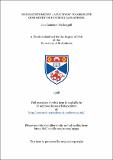Nanoscintometry : a pathway to absolute dosimetry of ionising radiations.
Abstract
It is now accepted that the deleterious effects induced by ionising radiations in mammalian cells are caused by the simultaneous breaking of both strands of the DNA helix by a single track. These effects are optimised when the mean free path of primary ionisation. lambda, matches the 2 nanometre mean chord distribution of DNA. However, there is currently no method of measuring radiation damage in terms of lambda. The aim of this project has been to design and construct a detector with a lambda response function capable of providing a measure of the absolute biological effectiveness of a radiation, independent of radiation type. Organic scintillation molecules, in the condensed phase, have been identified as being most suitable for bio-effectiveness measurements. Tissue equivalent and of comparable interaction cross-section, these nanodetectors are capable of signalling individual interactions with the emission of a scintillation photon, or scinton. Using a 20 mum scintillation film and DEP hybrid photodiode, spectra containing single and plural scinton events were recorded. These spectra reveal unique differences in the radiation quality of photon-emitting radioisotopes. A model of radiation action on scintillators in the condensed phase, analogous to the direct and indirect actions observed in intra-cellular DNA, has been developed and used to predict the characteristic yields of single and plural scinton events. The model was further developed to provide probabilities of paired' scinton events originating from fluor sites with a mean spacing of 2 nm. These critical 'paired' events are representative of double strand breaks and interpretation of these events that will yield bio-effectiveness data. Using Poisson distributions, a scintillator with optimised fluor concentration was developed for use in bio-effectiveness detectors. Loss calculations within the detector revealed an inconsistency in exponential attenuation theory, which appears to be inadequate when applied to light-guides. Consequently a new model of photon transport in light-pipes based on a Monte Carlo simulation has been developed and offers a more rigorous alternative. Calibration of the detector highlighted the need for a simple yet effective technique for photomultiplier tube (PMT) gain calibration in the laboratory. A technique using Cerenkov radiation was developed and provides good correlation with published gain figures. Although this prototype detector has not yet been fully tested, nor the associated bio-effect model fully developed to allow extraction of bio-effectiveness data from the collected spectra, preliminary results suggest this technique to be promising alternative and offers a route towards the measurement of absolute dosimetry with potential application in radiotherapy and radiation protection.
Type
Thesis, PhD Doctor of Philosophy
Collections
Items in the St Andrews Research Repository are protected by copyright, with all rights reserved, unless otherwise indicated.

